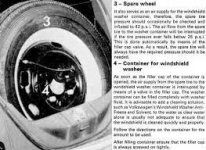Toyota tried controlling the heat by restricting the flow of antifreeze through the heater core.
Up until potentially the latest 2022-2023 models (I haven't driven any of our newer tractors enough to confirm), a lot of Volvo class 8 tractors still used this method. If you cranked the heat the max, you got heat fast, but when you cranked it down it takes a good 2-3 minutes to cool down as it slowly turns off the coolant flow and then the heater core and ducts all very slowly cool off. Such a dumb setup.
The windshield washer system ran off the air in the spare tire, not the wipers.
View attachment 65089
Core memory unlocked...I remember seeing this system in the frunk when we were converting VW Bugs into dune buggies in the 80's.
Anyhow, my take on the whole EV conversion by 2035 or whatever thing.....as most here know I'm a big EV guy, but honestly, I think this is unlikely to be successful inside that timeline. I'm a big fan of EV's, but I've also been an owner long enough to be a realist, and I know that there's large swaths of the country that do not, and will not have the infrastructure required for this by that time
unless the federal government mandates charging infrastructure, and probably pays for it as a result.
The reality is that what's out there is just too far flung in many rural areas, and often (and more importantly),
simply can't be relied upon as the third party mishash of companies that run a lot of these stations rushed to install them using past federal grants blah blah blah, but then just don't maintain them, or dump off the maintenance on the property owners where they're installed, property owners who often don't really care about them and care to fix them when they're broken. And broken they often are.
Hell, even the new stations at a lot of the Petro Canada stations were offline back when we owned our Ioniq, and they were only months old at the time...and the worst part was that the station attendandants would just shrug their shoulders and say "call the phone number on the charger, we can't do anything at all". A few weeks ago I was at the Scarborough Town centre and bunch of their Flo stations were broken. 2 are still offline months later at the Oshawa centre. Don't get me started at a bunch along highway 7 headed to Ottawa that are/were often broken and offline.
Until we get to a level of infrastructure across the
entire country, even in exceptionally remote areas (James Bay Road, anyone?), this really isn't realistic IMHO.



















